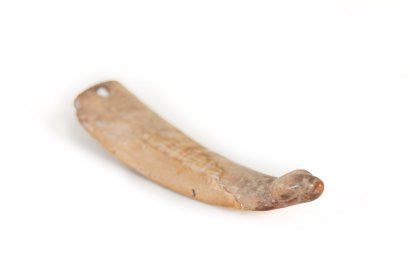A Rei Puta, one of the rarest forms of Maori self-decoration, has beaten its high-estimate by 37.7% at an auction in New Zealand.
Valued at NZ$20,000-40,000, the Rei Puta, made from whale tooth between the 13th and 15th centuries, sold for NZ$55,100 ($45,100) at the Wellington auction on March 28.
Worn around the neck to signify status by the ancestors of the Moa hunters of Aotearoa (modern day New Zealand), the style of the Rei Puta goes back to eastern Polynesia and the first band of adventurers to arrive in Aotearoa around AD 1,000.
 A Rei Puta sold for $45,100 |
Typically, Rei Puta have a curved form with a seal-like head and each has a pierced hole. In 1769 Sydney Parkinson, who travelled with Captain Cook as his official artist, painted a chief's son wearing the adornment.
They later became less popular, overshadowed by Hei Tiki neck pendants fashioned from nephrite or bone.
A kahu huruhuru was the highest priced cloak at the auction, selling for NZ$46,900, while an early kaitaka paepaeroa specimen made NZ$35,200.
A collection of 33 Oceanic fish hooks, estimated at NZ$40,000-60,000, also performed above expectations, achieving NZ$72,700.
Meanwhile, a carved matua fishing hook made NZ$10,900 and one of the largest Maori whalebone fish-hooks ever seen achieved NZ$9,100.
Carved figurines also performed well, with a NZ$36,900 ancestral figure the pick of the bunch.
Paul Fraser Collectibles will bring you more from across the spectrum of the world's aboriginal art auctions throughout the year, so make sure you check back here regularly.






